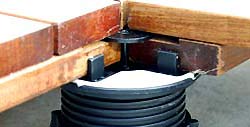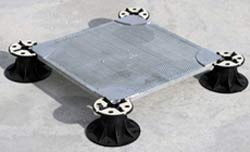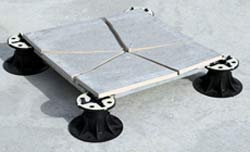Wind Uplift Considerations
Options for holding down pavers more securely in high wind locationsSince a pedestal paver system essentially relies on pavers being held in place on top of the pedestals by their own weight, in very strong wind locations there may be a requirement for pavers to be more tightly secured, not only to the pedestal heads over which they are laid, but also to the substrate on which the pedestals are positioned. Whilst no official standard and associated test method currently exists relating to the installation of pedestal supported pavers on roof decks, some limited research has been carried out investigating the wind uplift of concrete pavers simulating conditions on the flat roof of a low rise building.
One such study entitled Full-scale aerodynamic testing of a loose concrete paver system was commissioned by Wassau Tile and accepted for publication by the Elsevier journal in May 2012. In this study, the aerodynamic wind loads acting on 2′ x 2′ x 2.5″ thick concrete pavers supported on 12″ high pedestals were investigated by the Wall of Wind facility of Florida International University. One of the principal conclusions of this research was to show that by locking a group of loose pavers together, sufficient weight was produced such that the interlocked pavers acting together could counterbalance the net uplifting loading caused by the wind. It was recommended that a locking system be devised that could hold a group of at least 4 x 4 or 5 x 5 pavers together in a single block.
A more recent study entitled Wind Uplift of Concrete Roof Pavers was conducted by the Wall of Wind facility of Florida International University and the paper presented at Structures Congress 2014. The study was undertaken with 12″ x 12″ x 2 1/2″ thick concrete pavers. Wind blow-off tests and pressure measurements on the top and bottom surfaces of the pavers were performed focusing on net pressure distributions and an examination of the ratio of spacing between pavers to the pedestal height on the susceptibility to blow off. Adjustable height pedestals were used to change the height between the pavers and the roof surface. A constant gap of 1/8″ was maintained between the pavers while pedestal heights were varied from 1 1/4″ to 4 1/2″. The principal conclusion was that increasing the ratio of the spacing between pavers to the height of the deck off the roof surface increases the wind speed at which blow off of the pavers will occur.
Neither of these studies incorporated 3/4″ thick porcelain pavers in the test methodology and the conclusions reached in the latter study are not particularly practical for most elevated paver installations where the paver spacing is fixed and the pedestal height is controlled by a number of factors and will most likely vary across the width of the installation. Consequently Archatrak (under our former name of HandyDeck Inc.) commissioned a study by the Wall of Wind facility in Florida to specifically investigate the wind speed at which blow off of both 24” x 24” x ¾” porcelain pavers and 24″ x 24″ structural Ipe wood tiles pavers would occur. Variables incorporated in the study included different parapet levels, different angles of wind, both fixed 1/2″ high supports and 8″ high Eterno adjustable pedestals and different laying configurations of the Ipe wood pavers.
Further details of the study are available from Archatrak on request, but to briefly summarize the main results, lift off of pavers occurred under the following conditions:
i. Ipe wood pavers on 8″ high Eterno SE5 pedestals with 12” high parapet: 130 mph at 0° wind angle
ii. Porcelain pavers on 1/2″ high fixed‐height supports with 0” high parapet: 130 mph at 45° wind angle
iii. Porcelain pavers on 1/2″ high fixed‐height supports with 12” high parapet: 150 mph at 30° and 45° wind angle
However movement or shaking of the pavers and tiles (as defined by movement up or down of approx. of 0.5″) was observed at 80 to 90 mph. Pavers that shook or bounced in such circumstances were liable to break off the spacer tabs on the adjustable height pedestal heads. This highlighted the need for any hold down device to prevent pavers or tiles from bouncing or moving on the pedestal head and ensure that pavers are held as tightly as possible against the spacer tabs.
The main difficulties in devising suitable hold down mechanisms are to ensure that any visible fixing devices are attractive in appearance, that the strength of the pavers are not compromised in any way, that pavers can still be removed for inspection underneath if required, the installation time or difficulty is not significantly increased and the overall cost of the system is not increased unreasonably.
There are several systems currently available that are designed to increase the wind uplift resistance of pavers on on pedestal supported decks.
Hold down screws and adhesive
The simplest solution is to insert a screw and washer assembly into the pedestal head at the intersection of the pavers with the washer acting as the hold down device. With a porcelain paver deck, it means the screw and washer will be visible on the top surface, but with wood pavers the washer is concealed in a slot cut into the edge of the pavers.
Archatrak supplies a stainless steel screw and washer assembly specifically for use with Eterno pedestal system and porcelain pavers. The washer is 1.0″ in diameter and 3/16″ high.

Hold down screws on porcelain pavers

Screw and washer in Ipe wood tile

Adhesive applied to pedestal base
To provide additional hold down security on pedestal paver systems, adhesive can be applied to the base of the pedestal. The adhesive used will depend on the substrate the pedestals are laid on – for most installations over waterprooof membranes, Adco Millennium LPS is recommended.
Metal Protection Tray
For decks requiring higher support pedestals or where hold down devices must not be visible, we suggest using Archatrak steel protection trays. These trays serve the dual purpose of providing protection if any porcelain paver should crack due to impact with a heavy object as well as providing additional wind uplift resistance. The fireproof galvanized steel trays are attached to the Eterno pedestal heads using the same screw and washer assembly shown above for the Ipe wood tiles. Porcelain pavers are fixed to the steel tray by applying adhesive at each of the corners. Further wind protection can be achieved by applying adhesive to the pedestal base as above. The steel tray adds only approx. 1/4″ height and can be used with most 3/4″ thick 24″ x 24″ porcelain pavers.

Steel protection plate on pedestals

Porcelain paver on protection plate

Damaged paver supported by plate
Plastic Injection molded trays
With this system, each corner of a honeycomb structural plastic tray is placed on pedestal heads and locked into the pedestal using a screw and washer assembly. The paver is attached to the honeycomb tray using a suitable adhesive. These trays are typically made to accommodate only one specific size of porcelain paver (slight differences in porcelain paver size exist between different manufacturers) and will also add approx. 1.5″ to overall height of the deck assembly, which may be a critical issue in certain installations. Whilst such plastic trays may pass the ASTM Test Method E108-11 “Standard Method of Fire Tests of Roof Coverings” which measures the surface spread of flame and the ability of the roof surface material to resist fire penetration from the exterior to the underside of a roof deck, in some situations, be aware that such a continuous grid of plastic material may not meet local fire regulations.
Fiberglass Grid
A more expensive option is to lay large format fiberglass grid panels (typically 30″ x 48″ x 1″ thick) over the entire area, again supported by pedestals, and then attach the pavers to the top of the grid using a suitable adhesive. As with the plastic grid system, a continuous elevated fiberglass grid may not meet local fire regulations in some locations. Note also it would be difficult if not impossible to lift up any pavers for inspection of underlying waterproof membranes with this system.
Please note that Archatrak has not conducted or commissioned any wind uplift testing with any of the hold down devices mentioned above and thus we can offer no guarantee as to the efficacy or the improvement that any of the devices may provide in increasing the wind speed at which lift off of pavers will occur.

